
Redesigning partner experience in Industry 4.0 A well-defined partner strategy and engagement model can help drive enhanced customer experience and outcomes
14 minute read
23 October 2020
As end-to-end digital industrial solutions grow more complex, companies need to leverage the partner ecosystem across the value chain. This article, 13th in a series, discusses how companies can capture value by redesigning their partnership infrastructure model.
Introduction
In Industry 4.0, companies are transitioning from creating and selling products to working to achieve customers’ business outcomes. To sell, deliver, and support solutions that fulfill customer needs, companies are redesigning their customer operations and sales models. And as organizations undergo this shift, leaders need to rethink their partners’ role in driving competitive differentiation, accelerating time to market, scaling faster, and delivering better customer experience and outcome.
In our previous article,1 we suggested four partner archetypes that have emerged, based on how they add value and collaborate in the value chain along with the level of integration and strategic partnership nature (figure 1).
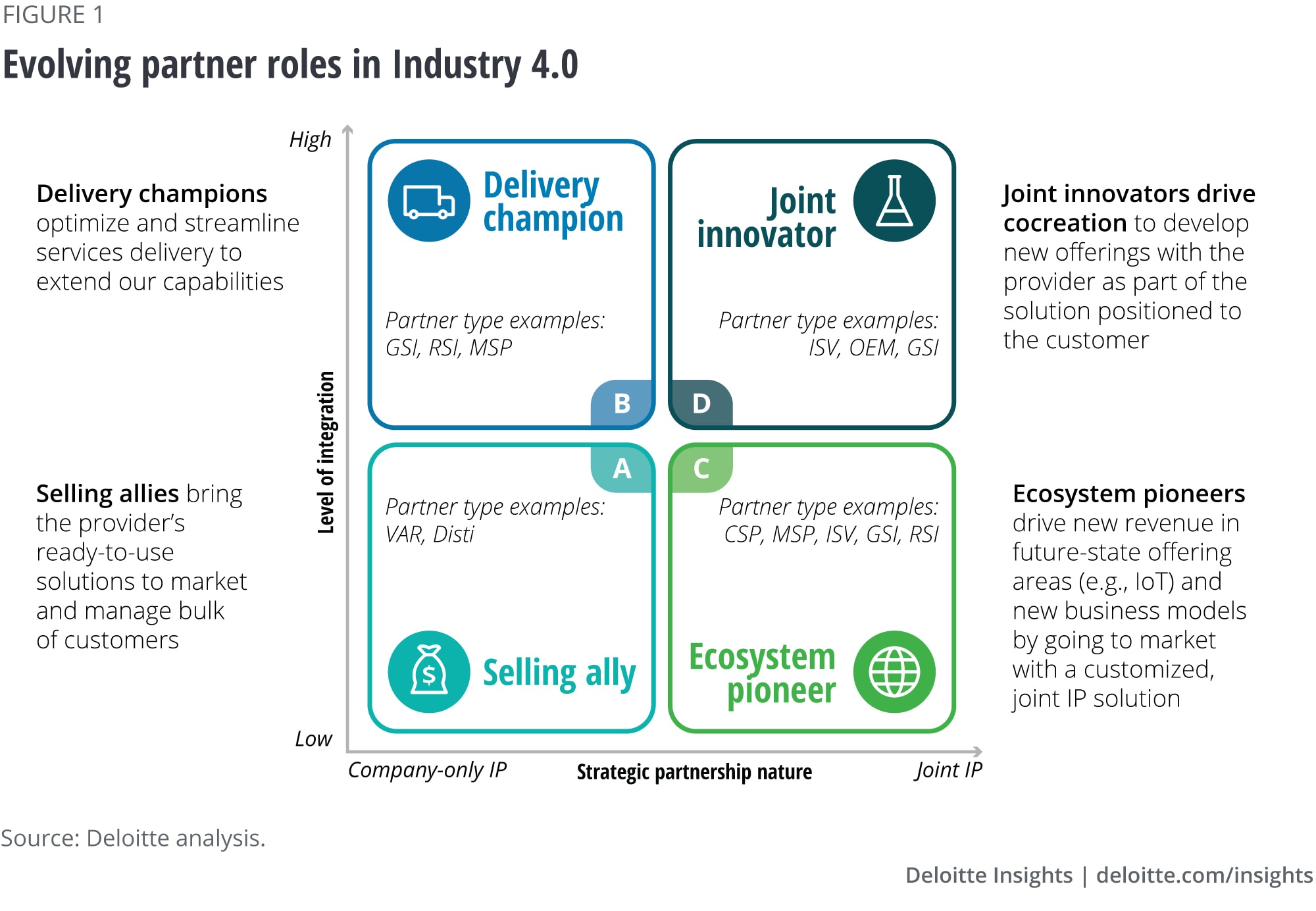
Learn more
Explore the Digital industrial transformation collection
Learn about Deloitte’s services
Go straight to smart. Get the Deloitte Insights app
To cultivate this ecosystem evolution, vendors should look to establish and support an integrated and comprehensive partner community that both creates and captures value in the market. And to achieve this, they must understand what the partners expect and the biggest pain-points with their recent engagement experience.
The 2112 Group’s 2019 ease of doing business report found that nearly three-quarters of partners complained about overly complicated partner programs and said they look for increased support, transparency, and predictability in programs. Close to 40% wish for consistent rules of engagement, improved training programs, and simplified incentive management. Fully 61% of partners feel that they have insufficient strategic guidance and would like more transparent market development fund (MDF) requirements, while 70% of partners feel that the onboarding processes have too many steps and could be streamlined.2
Drawing from this analysis, we suggest focusing on four strategies to set up a partner infrastructure that can support the needs of all partner archetypes:
- Clarify and customize the value proposition to each partner archetype
- Design a partner program with a foundation that’s consistent but flexible enough to cater to different archetypes
- Launch a flexible yet simple incentive structure
- Augment financial metrics with leading customer and enablement metrics
Factoring in the unique needs and complex interaction models with each partner archetype will be critical to successfully implementing these strategies.
1. Clarify and customize the value proposition to each partner archetype
Given an increasingly broad range of partnering options, it has become imperative for companies to carefully consider and tailor their value proposition to become and remain an attractive and trusted business partner. In a recent interview, Salesforce indicated that "companies need to think of partnerships as relationships that evolve over the years, driven by the customer desired outcomes. They ought to acknowledge that each partner has unique strategies, capabilities, and requirements. Hence, the partnership strategy has to account for a partner's needs and create joint value propositions that address customer outcomes effectively."3
Hence, partner marketing organizations focused on partner recruiting need to customize the value proposition to focus on the elements critical to the specific archetype. Across all partner archetypes, we see three elements as consistent or equally important, focusing on portfolio value, ease of doing business through the engagement model, and financial returns or profitability:
- Portfolio value. Level of customer demand and alignment of the road map with industry leaders.
- Engagement model. Ability to sell quickly and efficiently, with partners enabled through a partner portal.
- Profitability. Level of margin opportunity and cost to be a partner.
Ultimately, partnerships are about driving and scaling value for both sides; therefore, partners need to be convinced that these table-stakes elements are sufficiently attractive to warrant the cost of doing business.
The partner concerns around enablement and support—such as administrative overhead, undefined engagement, and outdated training and support—also make it imperative to consider the following six elements, as part of a value proposition, in addition to the three core elements:
- Collaboration. Resources and platforms to facilitate collaborative development, selling, and delivery.
- Transparency. Early access to the product road map and joint planning—geography, accounts, etc.
- Support. Access to technical resources and experts, with dedicated partner managers.
- Predictability. Accountability and planning to meet milestones, with timely communication on program/incentive changes.
- Enablement. Access to joint selling playbooks, marketing resources (such as enablement kits), and competitive battle cards.
- Efficiency. Access to efficient pricing mechanisms (such as prequalified pricing for specific ingredients) and payment cycles as well as streamlined ordering services.
Each of these elements is more or less important to each archetype (figure 2).
Selling allies are looking for support to seamlessly close deals, which implies clear rules of engagement between direct/indirect sales and streamlined and efficient partner processes—for example, deal registration and invoice payments. Moreover, selling allies also need marketing support, such as “how to sell” materials, competitor battle cards, and MDFs for demand generation.
Delivery champions require enablement and support to drive efficiency and accelerate collaboration in delivery. For such partners, companies need to support joint account and pipeline planning for both sales and services. Delivery partners generally work closely with the vendor and must be given access to advanced technical experts with premium service-level agreements, technical manuals, guidelines, and playbooks.
Ecosystem pioneers require early access to product road maps and training courses to empower them with the knowledge and industry-recognized accreditations to build and implement new solutions. They also need access to marketing, sales, and technical resources to help partners cultivate enterprise-level, open-source development capabilities around a company’s solutions.
Joint innovators tend to invest in vendors who provide visibility to the product road map and an engagement model that makes it easy to codevelop with their engineering teams or other partners for a more comprehensive portfolio. Vendors and ecosystem pioneers collaborate with joint product road maps, sales planning, and sales playbooks.
Figure 2 details each archetype’s unique set of priorities.
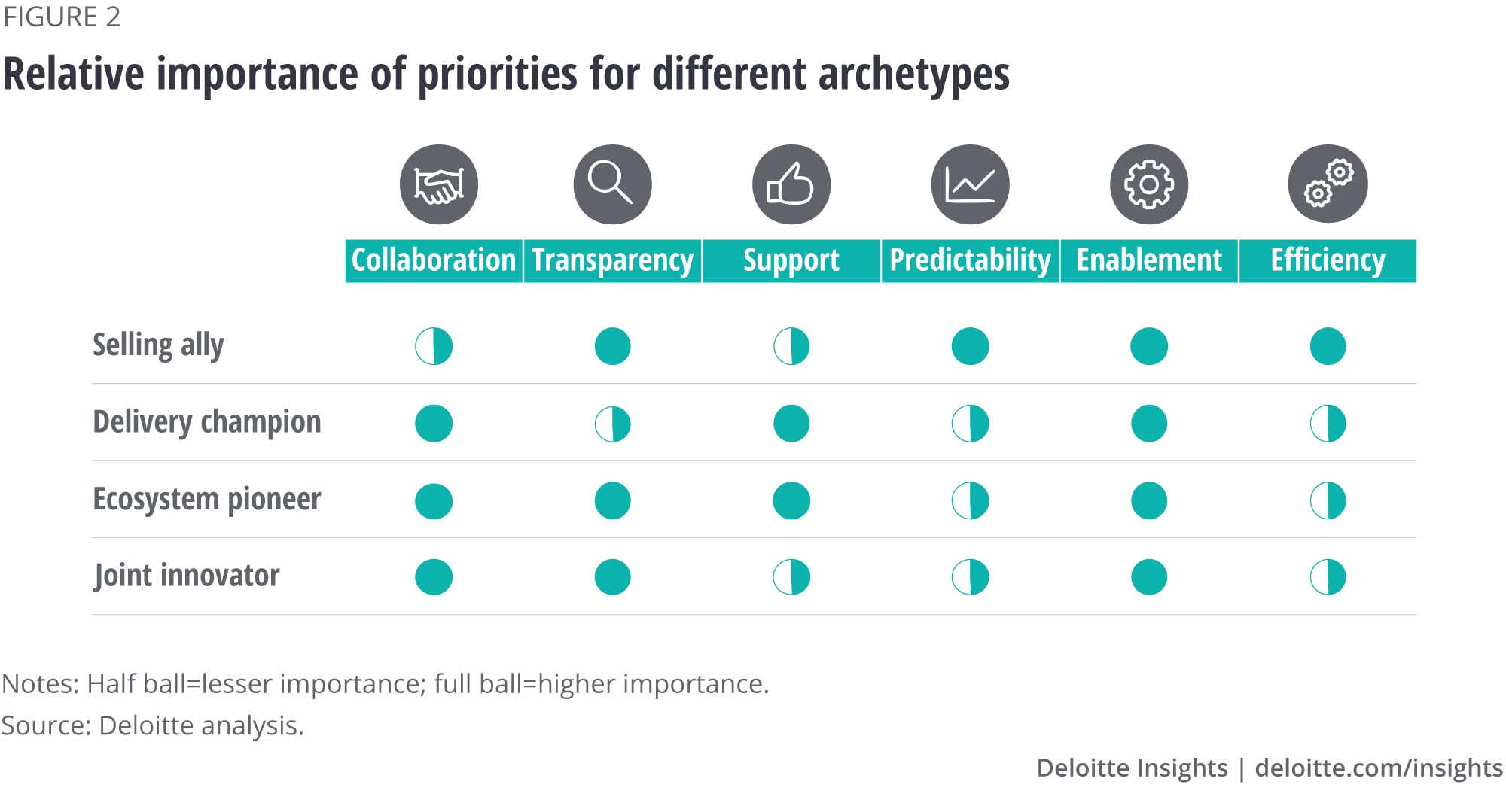
Case study: Deloitte-HPE alliance
HPE's alliance with Deloitte is an example of the unique ways in which vendors are changing how they collaborate with partners—infusing their unique expertise at various parts of the value chain and customizing their value proposition to meet the partner's changing needs.
In recent years, Deloitte's role with HPE has evolved from a pure-play service provider to a strategic alliance partner. As part of the alliance, Deloitte and HPE are codeveloping offerings across SAP, hybrid IT, edge computing, and the Industrial Internet of Things. These joint offerings combine Deloitte's deep industry and functional experience with HPE's innovative technologies.
Key principles around transparency and collaboration are central to HPE and Deloitte's partnership. Early into the process, HPE provided Deloitte visibility into relevant product road maps and access to HPE's engineers and developers to support joint offering creation. As the companies take these to market, they maintain a joint pipeline and collaborate on go-to-market elements, such as sales enablement and marketing initiatives focused on achieving real business outcomes for clients. One example is HPE and Deloitte bringing clients to visit the TexMark's Refinery of the Future, together.4
2. Design a partner program with a consistent but flexible foundation
With the value proposition defined and communicated to the partners, vendors must then focus on designing flexible partner programs that can cater to different partner archetypes and help drive the strategic outcome expected within each relationship. One good example of this is SAP, which has four distinct partner programs for the different types of partners: One for equipment manufacturers and software vendors, another for value-added resellers, one for system integrators, and one for outsourcing or hosting partners.5
Sharing a holistic partner enablement strategy should allow the partners to shorten sales cycles, boost lead conversion rates, and build relationships. Without the right tools and programs in place, enablement programs can easily impede partner performance.
Enablement should happen in conjunction with established and comprehensive incentive programs. Partners need to be equipped with the skills, knowledge, and support to achieve the goals, objectives, and incentives to encourage desirable behaviors and/or address deficiencies in the value proposition.
In a recent ESG channel survey, partners suggested that nearly 90% of their top challenges were related to partner enablement.6 Tackling these challenges through an effective enablement strategy can help your partners gain a competitive advantage with external clients.
We envision a seven-step enablement process aligning with strategic partner objectives (figure 3).
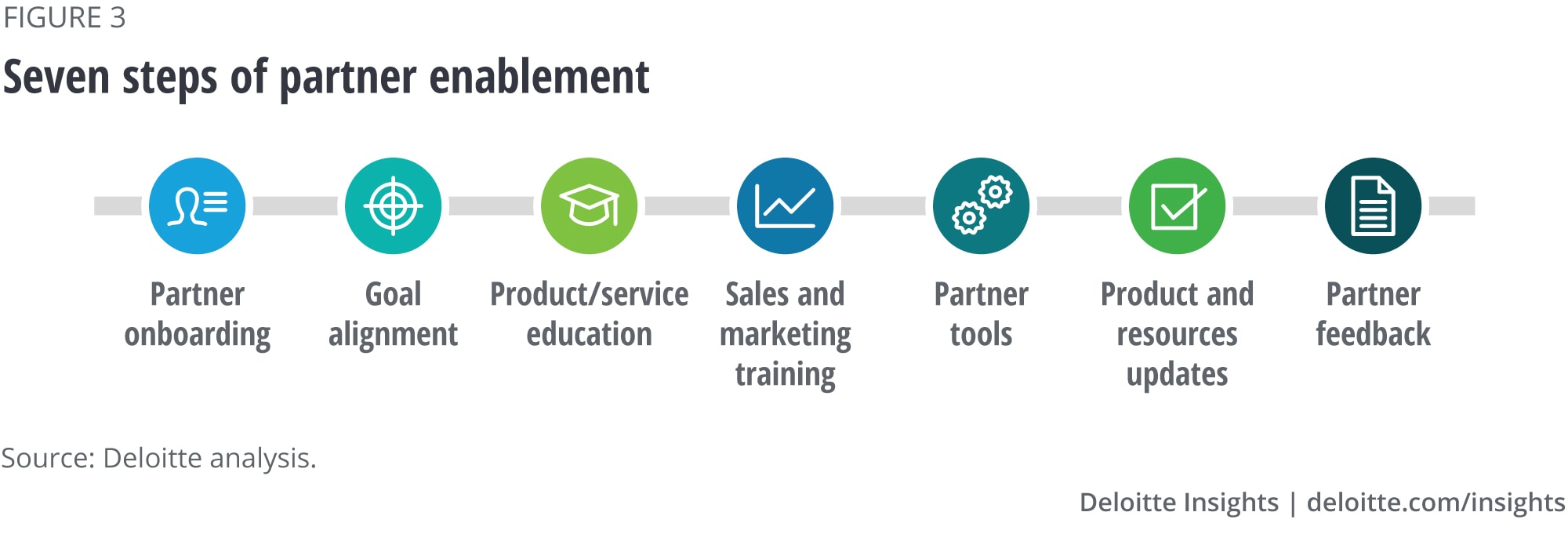
A structured, impactful partner onboarding can be the key to minimizing partners’ ramp time and establishing a solid foundation for strong partner relationships. An efficient onboarding process is a table-stakes requirement for more than a third of partners.7 Best practices involve conducting a comprehensive evaluation/study of your partner needs, using customized and targeted training, leveraging a learning management system to streamline training delivery, and providing tools to measure onboarding success. For example, Intel and Lenovo are widely known for their consistency in program requirements and ease of doing business.
Partner relationships need to focus on mutual success. Hence, it is critical to align business goals, which can be achieved by developing a joint business plan that clearly outlines objectives and expectations from partners and provides quantifiable and relevant measures of success.
Partners need holistic information on products and services to share that knowledge with current and future customers. Effective product/service education requires evaluating a current learning strategy to determine gaps and weaknesses, planning sessions to fulfill partner requirements, issuing certifications/rewards on training completion, and collecting feedback to drive improvements. For example, Intel rebranded its partner program and introduced new tools for training and collaboration. One of the key components of the new program is Intel Partner University, which aims to deliver targeted content to individuals based on their level of training and their company’s focus. Once the partners complete their training, they can receive competencies, added to LinkedIn profiles and other sites.8
Vendors need to ensure that marketing and sales teams are well prepared, knowing just product specs don’t suffice. This requires understanding how to overcome different scenarios, obstacles, and challenges they might encounter to implement your solution. This can be achieved through periodic joint sales calls, field visits, frequent and open lines of communication, modularization of content, and social connections. For example, Marketo focuses its partner program on providing strong sales and marketing support. The company provides partners with access to a partner community, an ongoing series of monthly training webinars, joint sales and marketing materials, and even subcontracting work to top-tier partners. 9
Partner tools and portals help ensure effective management of leads, revenues, opportunities, sales metrics, and tracking of inventory, pricing, discounting, and operations, for both vendors and partners. Vendors could leverage partner portals for data-sharing, management dashboards to measure the visibility of partners, integration with CRM, and partner relationship management data for success measurement while providing partners direct access to sales-related insights and performance. For example, HubSpot assigns a dedicated partner manager and provides a partner toolkit to manage referral leads, online training, and a public listing in HubSpot’s partner directory.10
Schneider Electric is another example of supporting partner operations through tools. Schneider Electric has invested heavily in growing its cloud-based capabilities, such as Smart-UPS enabled with APC SmartConnect, and has recently launched EcoStruxure IT.11 Both have helped Schneider gain significantly in enabling their channels by analyzing data to aid their partners to make more relevant and actionable customer recommendations. This, in turn, increases the partner’s value for end customers. Schneider also made changes to its deal registration program and molded it to improve partners’ profitability in selling its solutions. The company is also rewarding true solution-selling: Sales coverage in the field has been doubled, giving channel partners more “feet on the street” to support the development of customer projects.
It is essential to keep partners up to date on product changes and resources as, when they become available, they can share these with customers. Best practices involve quickly rolling out training on product updates, tracking whether partners have taken them, running annual refresher sessions, and using a platform to share issues and product-related information in real time.
Tracking and measuring success across your partner ecosystem and ensuring a two-way feedback mechanism to make partners better—and improve your business, product, or service—are a crucial component of partner engagement. For example, Google Cloud incorporated feedback from almost 150 partners, ensuring transparency and increasing partner adoption, to create a new information portal.12
Beyond the seven steps
While all seven steps are important for partner enablement, an excellent way to prioritize the steps is to map them to a partner’s most essential needs and then look to deploy capabilities for partners that are most strategic to a company’s portfolio. How do you prioritize your partner enablement strategy by partner type? By assessing the relative importance of partner enablement steps across archetypes (figure 4).
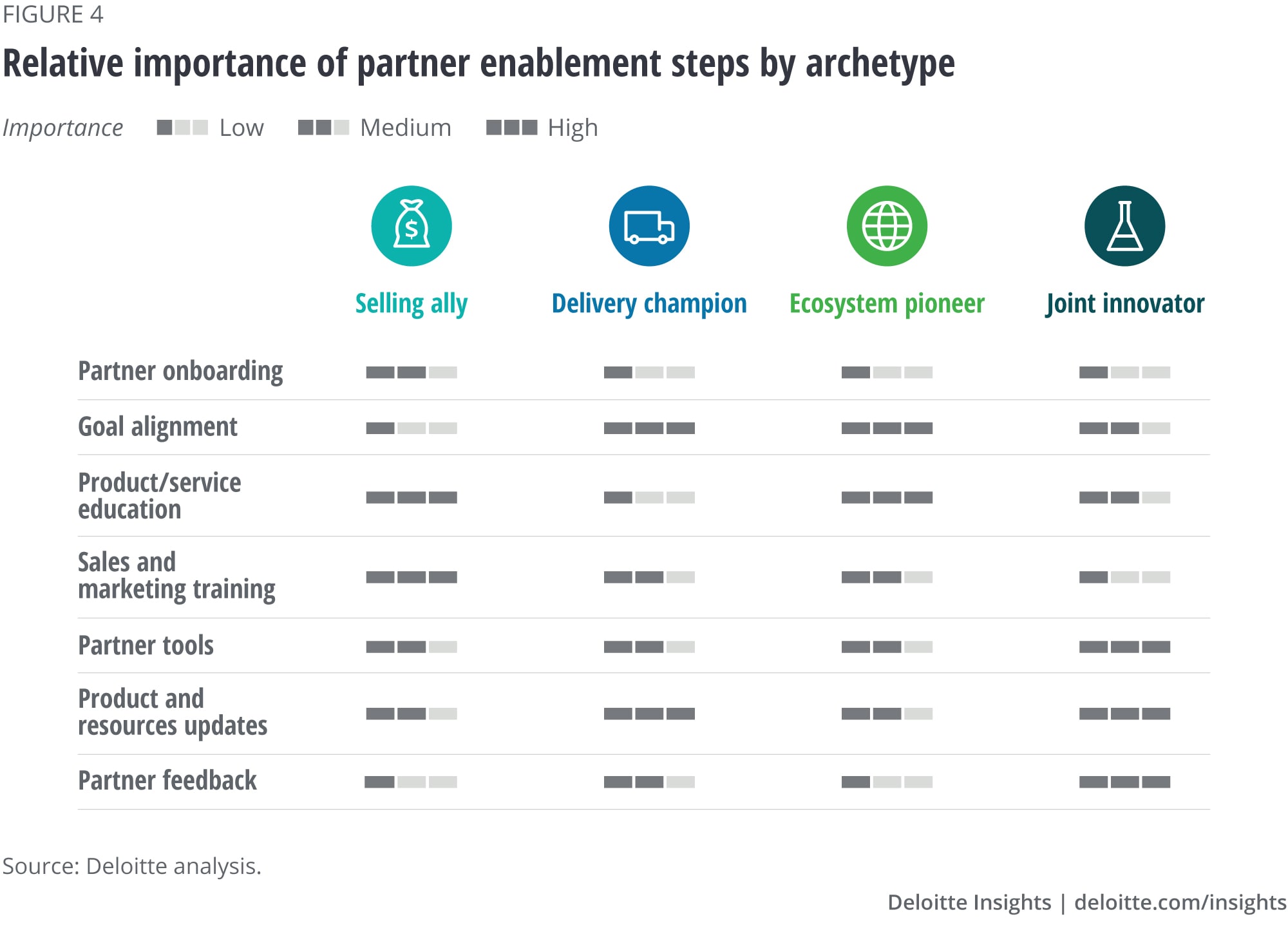
Companies can look to take certain steps based on the four archetypes:
As selling allies tend to be their customers’ primary purchasing advisers, it is crucial to provide them with comprehensive product/service education and advise them on how to sell those particular products/services effectively.
Delivery champions care about creating efficiencies for their clients. Therefore, they need to be apprised and kept up-to-date on product and resource updates, with a collaborative goal and objective setting.
Ecosystem pioneers strive to make collaboration easier and clear and require access to product/service information, with clarity on goals and targets.
Joint innovators aim to leverage vendors’ capabilities and market position and codevelop. Continuous communication on product/resource updates, supported by necessary tools, is crucial to facilitate codevelopment.
3. Launch a flexible yet simple incentive structure
While we know that ease of doing business and enablement are critical factors in the partner experience, the simplicity of the incentive structure is a close follower and indicator of partner satisfaction. “Partner roles and needs are constantly evolving, and vendors must design partner programs that are flexible and focus on value delivered,” says Kimberly King, vice president of global partner strategy and programs at Hitachi Vantara. “This requires the adoption of a collaborative approach for defining desired business outcomes and using metrics beyond just revenue or margin. Companies may be required to test and adopt different incentives and support mechanisms to drive greater engagement and solution ownership.”
Programs such as these help strengthen relationships and increase vendor attractiveness; however, there is a chance of them becoming too complex as companies try to incentivize and measure too many elements in a single program. To manage the potential complexity, it is helpful to think of partner incentives much more broadly than profitability.
We see partner incentives falling under five categories. With partners’ needs and roles varying across archetypes, vendors can leverage different incentives within each category to reward the desired behavior of an archetype (figure 5).
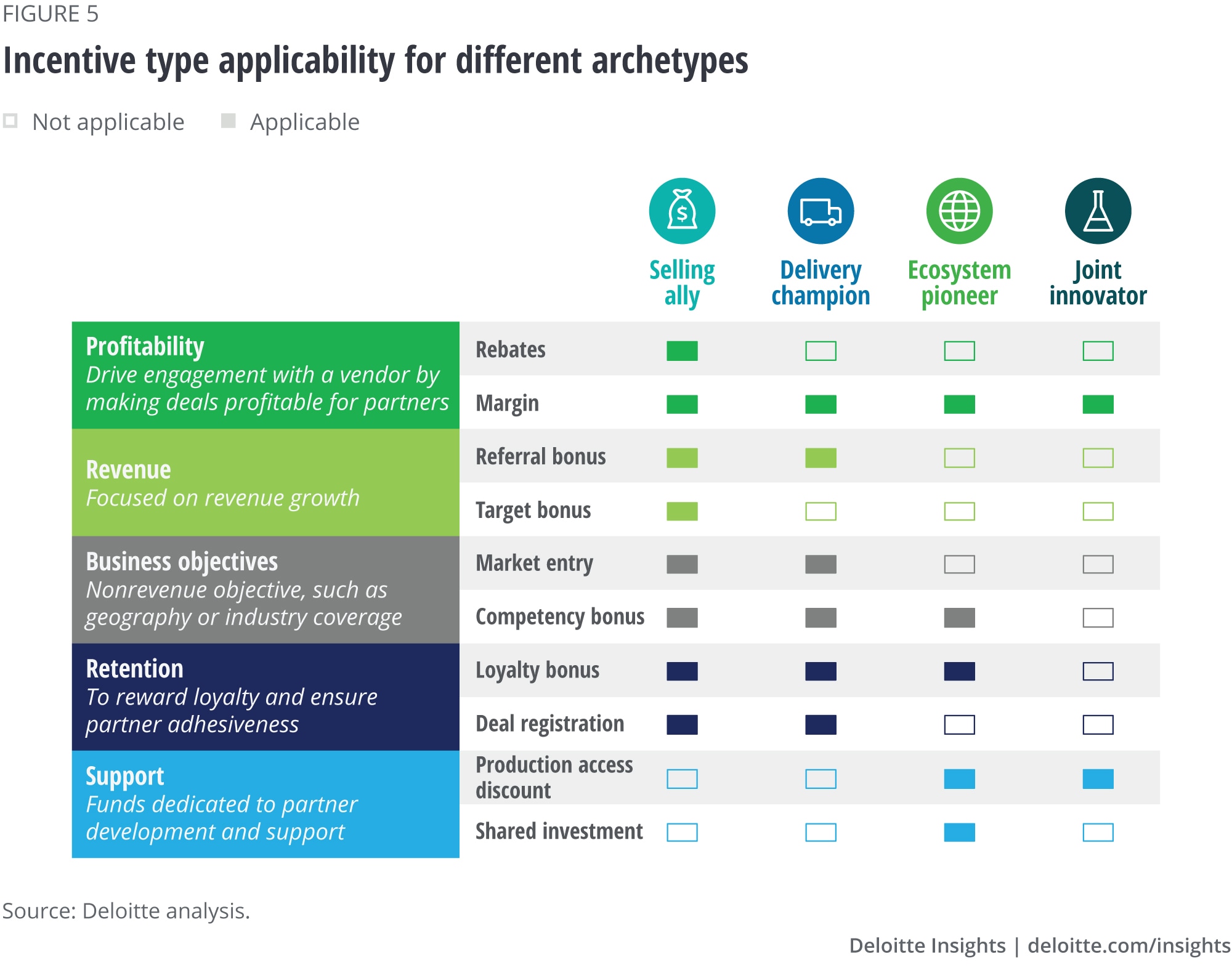
In the case of selling allies, it is crucial to provide incentives that drive profitability, grow revenue, expand coverage, and encourage partner loyalty. A way of promoting partner loyalty can be offering product discounts after a partner has been associated with an offer for at least two years. For example, Cisco’s VIP Annuity incentive program gives partners upfront rebates for landing a software-as-a-service deal and expanding or renewing SaaS deals with existing customers. The program applies to enterprise networking, data center, security, and collaboration sales with performance-based recurring revenue rebates.13
With delivery champions, the incentive program should focus on rewarding lead generation services and expanding vendor coverage.
Incentives for ecosystem pioneers should encompass marketing and training support to reduce partner costs and provide designated funds such as marketing development funds that can be used to drive product demand. For example, Salesforce has a vast catalog of certification programs covering different job roles such as developers, administrators, and architects.14
Joint innovators need significant upfront investments to run as solutions may not be ready for the market for months and even years. It is critical to provide them with investment programs to stay afloat in the meantime. Also, they should be incentivized to adopt the vendor’s product and cross-sell or bundle their products with others.
4. Augment financial metrics with leading customer and enablement metrics
Last, measuring the right key performance indicators is essential for the partnership’s health and success, as they are critical for informing decisions around incentive structures and investments. As partners’ role expands and business models evolve from transactional to subscription, channel metrics should capture short-term goals such as revenue and long-term objectives such as retention, renewal, upsell, and brand loyalty. Tracking leading indicators allows both sides of the partnership to evaluate the partnership’s health and address opportunities proactively. At the core of the partnership, financial performance remains paramount. Therefore, leaders need to consider financial KPIs such as year-on-year sales growth, profitability, and margins. But it is no longer enough to measure partner success on a financial basis: With the rise of flexible consumption and recurring revenue models, partners should track KPIs involved with resell, upsell and cross-sell deals, and customer experience, and tie them to incentives.
Hence, metrics can be broadly classified into the following categories:
- Financial. Indicates how well a partner is performing on parameters such as revenue and profits.
- Customer. Evaluates end-customers’ satisfaction and the partner’s ability to attract or maintain customers.
- Enablement. Measures the effectiveness of the support and training programs.
Some other metrics can be classified into these categories and applicability varying by archetypes (figure 6).

The number of metrics and complexity of capturing them in a time-bound, automated, cost-effective way can sound daunting. The key is to start small by dividing your channel into transacting and nontransacting. Look at existing partner programs and see whether there are quick wins in measuring and attributing value to activities of those nontransacting partners. Utilize available analytics to determine correlations between inputs (channel programs) to outputs (channel productivity).
Closing thoughts
As leaders look to scale and enter new markets in Industry 4.0, partners are a critical consideration for the go-to-market. Our research suggests that companies need first to evolve the definition and role of partners in their value chain and consider expanding the ecosystem’s value. Companies should look to develop a value proposition for each type of partner with clear rules of engagement and objectives, develop an enablement and incentive program that is aligned with the partner archetype, and ensure the metrics used to track the partnership’s success are bimodal, communicating both the value delivered and received by both sides.
The next installments in our series will delve deeper into customer success, a critical capability of outcome-based solution selling in Industry 4.0, and how to extend it to partners.
© 2021. See Terms of Use for more information.
Explore more insights
-
Radically transforming your support models Article5 years ago
-
Digital product management Article5 years ago
-
Scaling up anything as-a-service Article5 years ago
-
Customer-centric digital transformation Article5 years ago
-
Architecting an operating model Article5 years ago
-
Digital transformation as a path to growth Article5 years ago
















